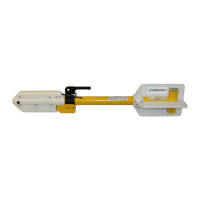Geometrics Inc. G-882 Cesium Marine Magnetometer Page
C. Analog channel 1, the depth sensor, will exhibit a value near 0100
(unscaled) with the G−882 in air out of the water. If no depth
sensor is installed in the G−882, the value could vary between
0000 and 0050. If the G−882 is in the water the value should vary
with and be indicative of depth.
D. Analog channel 2, the altimeter, will exhibit a value near 9900
(unscaled) with the G−882 in air, out of the water. If no altimeter
is installed in the G−882, the value could vary between 0000 and
0050.
If the additional diagnostic analog channels are enabled the following
may be observed:
E. Analog channel 3, the brightness, will exhibit a value around
5600, but may vary between 5350 and 5850.
F. Analog channel 4, the RF, will exhibit a value around 2100, but
vary between 2000 and 2400.
G. Analog channel 5, the heater, will exhibit value around 1740, but
vary between 1700 and 1900 depending upon ambient
temperature.
H. Analog channel 6, if not used, could vary between 0000 and
0050. As shipped, jumpered to an internal voltage, 28V, analog
channel 6 could exhibit a value around 6500, but vary between
5005 and 7090. If used for an external input (this capability not
currently implemented in the G−882), the values will depend upon
the characteristics of the user device attached.
I. Analog channel 7, if not used, could vary between 0000 and
0050. As shipped, jumpered to an internal voltage, 21V, analog
channel 7 could exhibit a value around 5100, but vary between
4600 and 5300. If used for an external input (this capability not
currently implemented in the G−882), the values will depend upon
the characteristics of the user device attached.
In either configuration above, nose or CG tow, the magnetometer can be lifted
over the side by one person. However, the deployment will be much easier and
smoother with two or more people handling the operation. Due to much lower
levels of drag force, the nose towed magnetometer may be handled by one
strong person. Cowhide work gloves provide the best protection and grip for
handling the wet tow cable.
There are two methods to handle the cable on deck if a winch is not used:
1. Neatly fake (figure eight) the cable down on the deck beginning with
the onboard end. As this is done remove any twists in the tow cable.
The cable may be deployed from the figure eight without knots and
kinks. One person should be assigned to tend the cable on and off of
the figure eight. This method is better for cable up to 120m (400ft).

